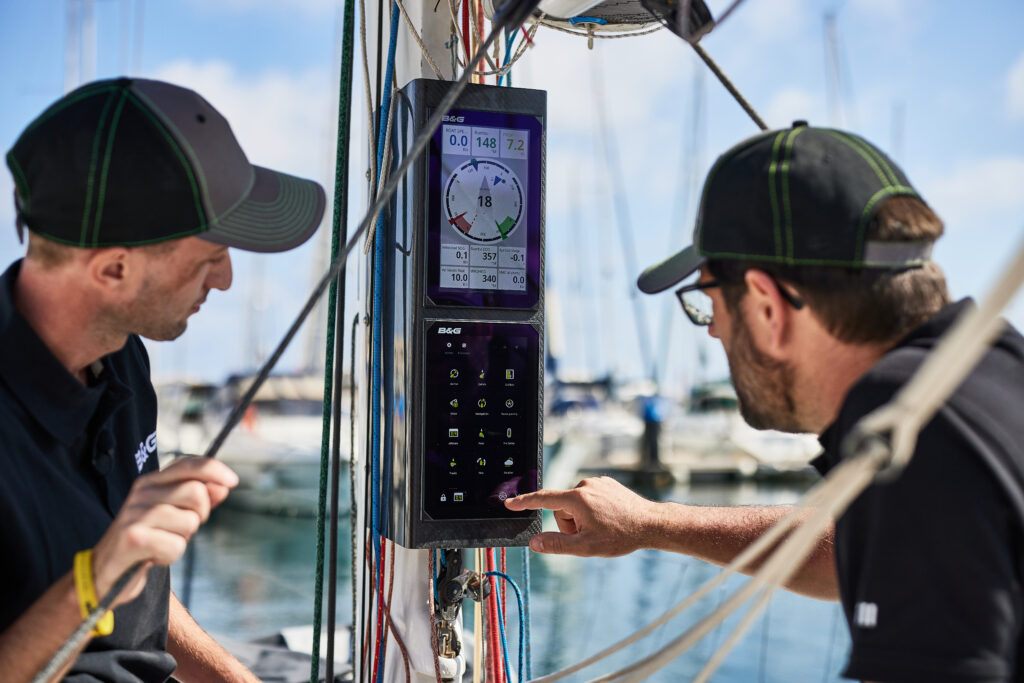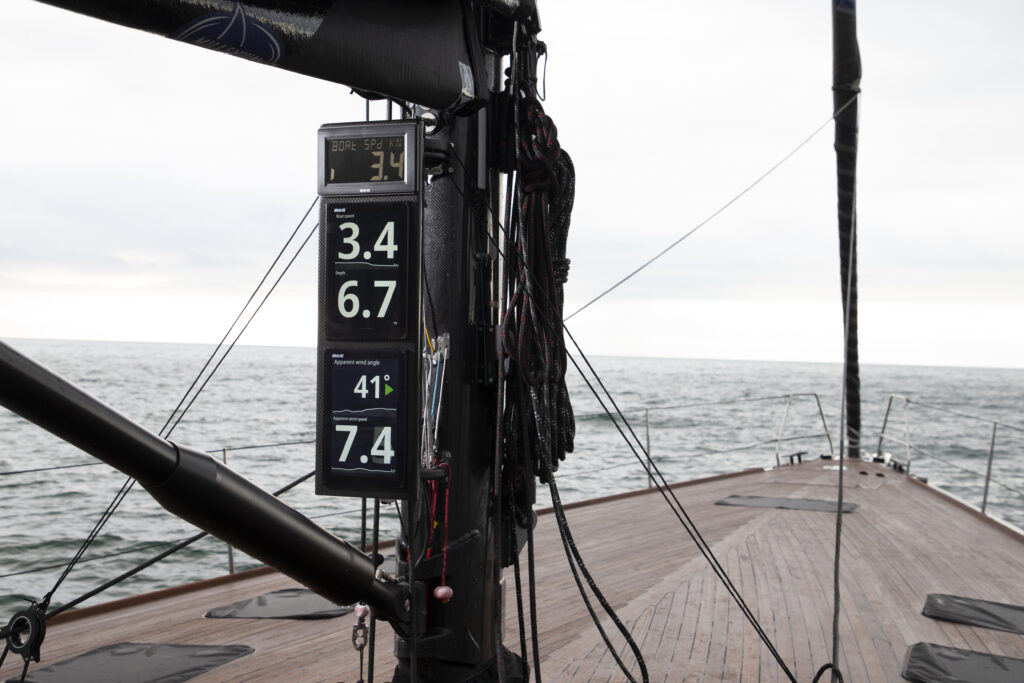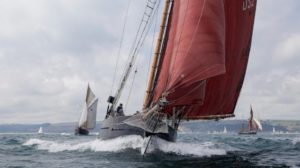Exploring marine electronics’ development via high performance teams

Boat speeds have taken a spectacular leap in the last decade as the grand prix, high-performance end of sailing has delivered a new level of performance that would get you a speeding ticket in suburbia. This is a world where crews regularly talk of 30 knots upwind and 40 knots downwind. To them it’s normal, says Matthew Sheahan.
Foiling is clearly one of the key ingredients where boats like the America’s Cup 75s, SailGP’s F50s and the giant Ultime trimarans travel regularly at three times the wind speed without blinking. Yet there’s far more to the foils and what makes them work than section shapes, lift/drag ratios, dihedral and other technical details. Away from the visual clues there has been a technical revolution behind the scenes that is en route, at least in part, to the mainstream marine industry.
Today’s foilers have become flying computers as sophisticated onboard systems help to tame the beasts in a similar way to ABS and traction control systems in our cars. In SailGP’s F50 class, the one design fleet that was born out of the 2017 America’s Cup class boats in Bermuda, advanced assistance is one of the key factors behind some of the huge increases in performance across the fleet. And it is this fleet-wide development and the rate at which the crews are learning that sends one of the strongest signals for the future of modern electronic systems in sailing.
Just like the regular updates that are taken for granted on our phones and computers, regular software updates to the onboard systems are improving many of the crucial functions from wing adjustment to flight control. And because the F50s are strictly one design and no longer the secret property of their teams, data can be, and is, shared throughout the fleet, which in turn allows crews to learn and apply new techniques.
Open access to the data log files from every boat after every session afloat, be it in training or in the heat of battle, means that the crews are learning rapidly from each other. This provides closer racing while accelerating the climb up an impressively steep learning curve.
Be it in 5 or 25 knots of wind, pull off an impressive foil to foil tack and you can be sure that the other teams will be looking at your data in detail to decode how you achieved it. And the next day they’ll be doing it too. Yet from the outside, while the constant march towards faster boats is impressive, grand prix foilers are perceived as having little in common with mainstream sailing.
What is far more probable, and indeed already happening, is that many of us will benefit from the developments that are less easy to see.
Among those on both sides of the technology divide is offshore and Olympic sailor and former Volvo Ocean Race CEO Knut Frostad. Having clocked up four laps of the planet in previous Whitbread/Volvo Ocean Races, he knows what the high-performance end of the sport goes through and where the source of the technology and trickle-down starts.
Today, as CEO overseeing the Lowrance, Simrad, B&G, and C-MAP brands, Frostad has a view of the future and how the sailing world may change. So, when asked about the role of marine electronics you might expect his reply to mention better algorithms for autopilot control systems and more accurate position and motion sensors and other technical details. But while he doesn’t discount these, they are not his starting point.
“I believe we are going into a place where user experience will come more and more in focus. I think now we have to make boating more accessible, easier without losing the finesse and the skills that are required,” he says. “So, I think that the interface between user and instruments will become more and more important.
“Integration is another big area for development. We are already seeing more new boats coming out from the yards with fully integrated solutions.
“Not only is this slicker, but it’s really positive for newcomers coming into the sport. There’s no reason why you should need a full toolbox and pile of manuals on the side. Personal computers are vastly more powerful than they were a decade ago but when was the last time you received, let alone read, a manual?
“We have just launched a new product, B&G Nemesis, which is a taste of what’s coming – a display where you can customise the screen to look exactly what you want it to look like. Because we have the ability to be connected to our customers we can see how they use their equipment which will enable us to make even better experiences. This means we can refine, improve and update their software more frequently without any hassle for the customer,” Frostad says.

But the future isn’t just about data displays. “We have just launched a new feature with our Simrad Autopilots where you can engage the autopilot just by turning the wheel,” continues Frostad. “You don’t have to push any buttons, engage or disengage the controls, you just grab the wheel and turn it. When you stop turning it, the boat goes back into autopilot mode. The future is in providing tools to handle boats with confidence and provide a better experience for those on board.
“I think fully autonomous boats in the recreational scene is still very far away. It’s far simpler to park a car than it is to moor a boat. Firstly, the boat is moving on a moving surface so to emulate what is going on with cars means that you need to control everything, the engine, the thrusters the helm, sensors, compass, GPS and so on and that is a huge task,” says Frostad.
“But there’s another reason why this area is different. For most people a car is simply a form of transport. On boats there’s a sense of pride in handling them and if you take the steering wheel away from the boater, you take a very big part of the reason he or she bought the boat in the first place.”
In the automotive industry the ability for sensors to interface with control systems is now becoming possible, but according to Gregoire Outters, general manager of Raymarine at Teledyne FLIR, this is an area that needs to be approached with care.
“We need to be mindful of the enjoyment that can be felt whilst in complete command of a boat and how this is ultimately a choice for a captain. In some circumstances though the helm may welcome more active inputs from onboard systems,” he says.
“Manoeuvring in tight spaces and marinas are examples of such situations,” Outters continues. “A recent technology breakthrough would be the Raymarine DockSense Control system, which uses object recognition and motion sensing software. This is installed with machine vision cameras which are set up to view a boat’s perimeter. Collectively, the system interfaces with modern joystick propulsion systems, assisting with steering and throttle commands to prevent collisions whilst manoeuvring in tight spaces, and provides peace of mind in traditionally more stressful situations.”
So, while the shape and style of the next generation of grand prix boats is changing radically, it’s often what we’re not seeing that’s having the biggest potential effect for the mainstream. And even then, it seems likely that the developments that are coming our way will still have to enhance rather than replace the very thing that we’re there to enjoy.
This article was originally published in MIN’s SIBS special edition, Sept 2021.










